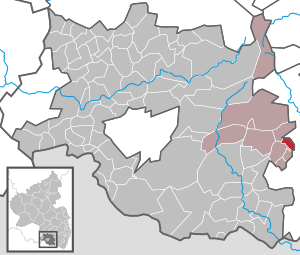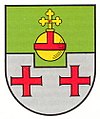Lug (Palatinate)
| coat of arms | Germany map | |
|---|---|---|

|
Coordinates: 49 ° 11 ' N , 7 ° 54' E |
|
| Basic data | ||
| State : | Rhineland-Palatinate | |
| County : | Southwest Palatinate | |
| Association municipality : | Hauenstein | |
| Height : | 211 m above sea level NHN | |
| Area : | 2.32 km 2 | |
| Residents: | 579 (Dec. 31, 2019) | |
| Population density : | 250 inhabitants per km 2 | |
| Postal code : | 76848 | |
| Area code : | 06392 | |
| License plate : | PS , ZW | |
| Community key : | 07 3 40 030 | |
| Association administration address: | Schulstrasse 4 76846 Hauenstein |
|
| Website : | ||
| Local Mayor : | Hermann Rippberger | |
| Location of the local community Lug in the district of Südwestpfalz | ||

Lug is a municipality in the Südwestpfalz district in Rhineland-Palatinate . It belongs to the Verbandsgemeinde Hauenstein , within which it is the second smallest municipality in terms of area. Before the regional reform in 1969, Lug belonged to the Bergzabern district .
geography
location
Lug is located in the so-called Wasgau , a low mountain range that is formed from the southern part of the Palatinate Forest and the northern part of the Vosges . in its sub-area Dahner Felsenland . The distance to the French border and Alsace is about 15 kilometers as the crow flies. Neighboring communities are - clockwise - Wernersberg , Völkersweiler , Gossersweiler-Stein , Schwanheim and Spirkelbach .
Elevations and waters
The place is located in the valley of the Rimbach , which flows into the Queich at the height of Annweiler . In the middle of the settlement area the Kisselbach flows into it from the left . The Triebborn, a right tributary of the Rimbach, forms the boundary to Schwanheim in the southeast. The settlement is located in a valley between Heischberg, Nesselberg and Höllenberg, most of which are already beyond the municipal markings. The center of the village with the church is about 210 m above sea level. NN, the highest point of the district Lug, the peak of the mountain Hell, has a height of 450 m above sea level. NN.
history
Lug is in a document of Emperor Heinrich III. , issued on September 7, 1046 in Augsburg , first mentioned in a document. Together with the village of Pillungisbach , Heinrich donated the hamlet of Lug, called Luoch in the document , to the Speyer Monastery . The name Pillungisbach could not previously be assigned to any of the present-day villages in the region.
There are several indications that Lug is much older: On the one hand, Heinrich III. in the document that he had already inherited the two villages from his grandmother Adelheid von Metz , on the other hand, a functioning mill already existed in Lug at the time of the donation .
Until the end of the 18th century, the place belonged to the Unteramt Landeck , which was jointly owned by the Electoral Palatinate and the Hochstift Speyer . After the Left Bank of the Rhine was taken by French revolutionary troops (1794), Lug was assigned to the canton of Annweiler in the Donnersberg department from 1798 to 1814 and was administered by the Mairie in Schwanheim . In 1815 the community had a total of 190 inhabitants. On the basis of the agreements made at the Congress of Vienna (1815), the Palatinate and thus also the municipality of Lug were initially assigned to Austria . In a treaty concluded in 1816 , Austria ceded the area to the Kingdom of Bavaria . The now Bavarian canton Annweiler belonged in the newly created Rhine district for the time being to the district of Zweibrücken formed from the previous arrondissement and came to the district of Landau on August 1, 1816. After the subdivision of the districts into land commissariats in 1818, Lug belonged to the Landkommissariat Bergzabern , which was converted into a district office in 1862.
In 1939 the place was incorporated into the Bergzabern district. After the Second World War , Lug became part of the then newly formed state of Rhineland-Palatinate within the French occupation zone . In the course of the first Rhineland-Palatinate administrative reform , the place moved in 1969 to the district of Pirmasens (from 1997 district of Südwestpfalz ) . Three years later it was incorporated into the newly created community of Hauenstein .
religion
In 2012, 72.2 percent of the population were Catholic and 12.6 percent Protestant. The rest belonged to another religion or were non-denominational. The Catholics belong to the Diocese of Speyer , the Evangelicals to the Protestant Church of the Palatinate .
politics
Municipal council
The municipal council in Lug consists of twelve council members, who were elected by a majority vote in the local elections on May 26, 2019 , and the honorary local mayor as chairman.
mayor
Hermann Rippberger became the local mayor of Lug on July 15, 2014. Since there was no candidate for the direct election on May 26, 2019, the upcoming election of the mayor was carried out by the council in accordance with the municipal regulations. He confirmed Rippberger on June 27, 2019 for another five years in his office. Rippberger's predecessor, Winfried Schäfer, had held the office for 25 years.
coat of arms
|
Blazon : "Divided by green and silver with a notch, above a golden imperial orb with a red ring and golden clover leaf cross , below two isosceles floating red paw crosses ."
It was approved by the Neustadt district government in 1984 . |
|
Partner communities
Partner municipalities are Mollkirch in France in the Alsatian department of Bas-Rhin and Lug , a district of Bronkow, in the state of Brandenburg .
Culture
Cultural monuments
With the Catholic Church of All Saints , a wayside cross and a cemetery cross, there are a total of three objects on site that are listed .
nature
The area around Lug is characterized by the bizarre, weathered red sandstone cliffs , some of which are among the tourist destinations of the Dahner Felsenland. The soils, however, are sandy and poor in yield.
The most important peaks in the Luger area are the Friedrichsfels - often alternatively referred to as Luger Friedrich - with a distinctive abseil point in the form of a protruding rock nose (total height 59 m) and the maximum 45 m high Luger Geiersteine , which are made from a massif with an equally distinctive rock nose ( Vulture's bill ) and the free-standing vulture tower . The vulture tower carries an iron weather vane .
Economy and Infrastructure
traffic
On the southern outskirts of the village runs the state road 495 , which connects the place with Hauenstein and Völkersweiler. From this, the district road 91 , which leads through the development, branches off , which leads in the direction of Wernersberg and Annweiler am Trifels . Lug is also connected to the local transport network via the bus route 525 of the Rhein-Neckar transport association, which leads to Bad Bergzabern and Annweiler am Trifels.
tourism
A branch line of the Palatinate Keschdeweg runs through the community . There is also a hut belonging to the Palatinate Forest Association on site .
Personalities
Sons and daughters of the church
- Walther Dahl (1916–1985), Air Force officer
- Franz Leschinger (* 1957), sculptor and member of Gruppe Twenty Ten
People who worked on site
- Winfried Schäfer, local mayor from 1989 to 2014, owner of the Freiherr vom Stein plaque since 2013
literature
- Günther Steigner: Lug in the course of history . Self-published by the municipality, Lug 2001.
- Günther Steigner: 950 years of Lug . In: Home calendar of the Pirmasenser and Zweibrücker country . 1996, p. 94-96 .
- Günther Steigner: The Wasgaudorf Lug . Local history. Stock, Annweiler am Trifels 1982.
- Philipp O. Abel: Thoughts and memories on the occasion of the consecration of the new Catholic Church in Lug . Lug 1929.
- August Becker : The Palatinate and the Palatinate . Plöger, Annweiler am Trifels 2005, ISBN 3-89857-193-9 . (First edition 1857)
- Udo Daigger, Hans-Jürgen Cron: Southern Palatinate . Climbing in the red sandstone. 4th edition. Plöger, Annweiler am Trifels 2005, ISBN 3-00-015457-4 .
Web links
- Local community Lug on the website of the Verbandsgemeinde Hauenstein
- Lug in the Palatinate
- Literature about Lug in the Rhineland-Palatinate State Bibliography
Individual evidence
- ↑ State Statistical Office of Rhineland-Palatinate - population status 2019, districts, communities, association communities ( help on this ).
- ↑ KommWis, as of December 31, 2012
- ^ The Regional Returning Officer Rhineland-Palatinate: Local elections 2019, city and municipal council elections
- ↑ a b c Mayor: Rippberger takes over. Die Rheinpfalz, May 14, 2014, accessed on April 5, 2020 .
- ^ The Regional Returning Officer Rhineland-Palatinate: Election of the honorary local and city mayors. Association municipality of Hauenstein. Retrieved April 5, 2020 .
- ^ The Regional Returning Officer of Rhineland-Palatinate: direct elections 2019. see Hauenstein, Verbandsgemeinde, fifth row of results. Retrieved April 5, 2020 .
- ^ Hauensteiner Bote: From the constituent meeting of the Lug Municipal Council on June 27, 2019. Linus Wittich Medien GmbH, edition 27/2019 (official announcement organ of the Verbandsgemeinde Hauenstein), accessed on April 5, 2020 .
- ^ Karl Heinz Debus: The great book of arms of the Palatinate. Neustadt an der Weinstrasse 1988, ISBN 3-9801574-2-3 .
- ↑ Ministry of the Interior Rhineland-Palatinate: Awarding of the Freiherr vom Stein plaque on October 22, 2013 in Wörrstadt. Serial No. 30 October 18, 2013, accessed April 5, 2020 .





